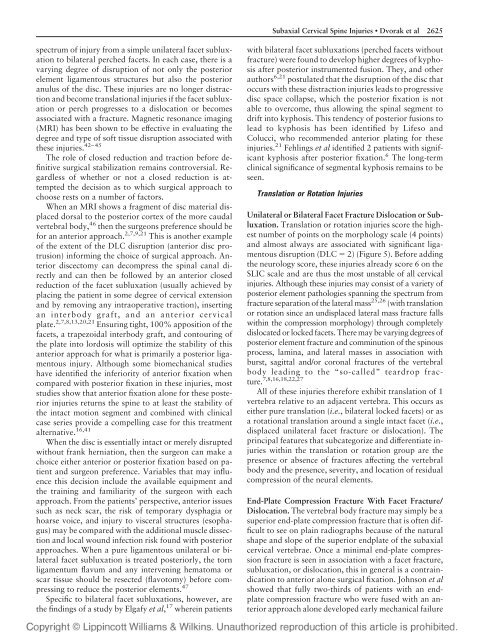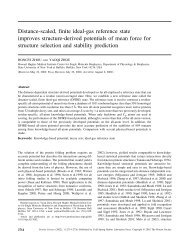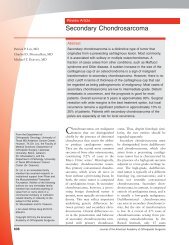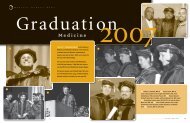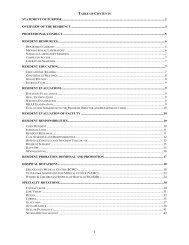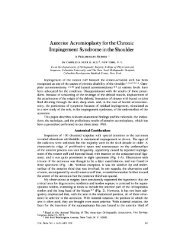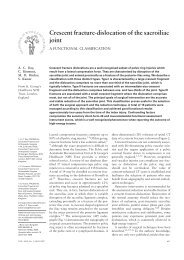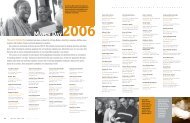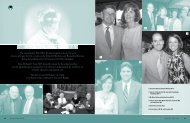The Surgical Approach to Subaxial Cervical Spine Injuries
The Surgical Approach to Subaxial Cervical Spine Injuries
The Surgical Approach to Subaxial Cervical Spine Injuries
You also want an ePaper? Increase the reach of your titles
YUMPU automatically turns print PDFs into web optimized ePapers that Google loves.
<strong>Subaxial</strong> <strong>Cervical</strong> <strong>Spine</strong> <strong>Injuries</strong> • Dvorak et al<br />
2625<br />
spectrum of injury from a simple unilateral facet subluxation<br />
<strong>to</strong> bilateral perched facets. In each case, there is a<br />
varying degree of disruption of not only the posterior<br />
element ligamen<strong>to</strong>us structures but also the posterior<br />
anulus of the disc. <strong>The</strong>se injuries are no longer distraction<br />
and become translational injuries if the facet subluxation<br />
or perch progresses <strong>to</strong> a dislocation or becomes<br />
associated with a fracture. Magnetic resonance imaging<br />
(MRI) has been shown <strong>to</strong> be effective in evaluating the<br />
degree and type of soft tissue disruption associated with<br />
these injuries. 42–45<br />
<strong>The</strong> role of closed reduction and traction before definitive<br />
surgical stabilization remains controversial. Regardless<br />
of whether or not a closed reduction is attempted<br />
the decision as <strong>to</strong> which surgical approach <strong>to</strong><br />
choose rests on a number of fac<strong>to</strong>rs.<br />
When an MRI shows a fragment of disc material displaced<br />
dorsal <strong>to</strong> the posterior cortex of the more caudal<br />
vertebral body, 46 then the surgeons preference should be<br />
for an anterior approach. 2,7,9,21 This is another example<br />
of the extent of the DLC disruption (anterior disc protrusion)<br />
informing the choice of surgical approach. Anterior<br />
discec<strong>to</strong>my can decompress the spinal canal directly<br />
and can then be followed by an anterior closed<br />
reduction of the facet subluxation (usually achieved by<br />
placing the patient in some degree of cervical extension<br />
and by removing any intraoperative traction), inserting<br />
an interbody graft, and an anterior cervical<br />
plate. 2,7,8,13,20,21 Ensuring tight, 100% apposition of the<br />
facets, a trapezoidal interbody graft, and con<strong>to</strong>uring of<br />
the plate in<strong>to</strong> lordosis will optimize the stability of this<br />
anterior approach for what is primarily a posterior ligamen<strong>to</strong>us<br />
injury. Although some biomechanical studies<br />
have identified the inferiority of anterior fixation when<br />
compared with posterior fixation in these injuries, most<br />
studies show that anterior fixation alone for these posterior<br />
injuries returns the spine <strong>to</strong> at least the stability of<br />
the intact motion segment and combined with clinical<br />
case series provide a compelling case for this treatment<br />
alternative. 16,41<br />
When the disc is essentially intact or merely disrupted<br />
without frank herniation, then the surgeon can make a<br />
choice either anterior or posterior fixation based on patient<br />
and surgeon preference. Variables that may influence<br />
this decision include the available equipment and<br />
the training and familiarity of the surgeon with each<br />
approach. From the patients’ perspective, anterior issues<br />
such as neck scar, the risk of temporary dysphagia or<br />
hoarse voice, and injury <strong>to</strong> visceral structures (esophagus)<br />
may be compared with the additional muscle dissection<br />
and local wound infection risk found with posterior<br />
approaches. When a pure ligamen<strong>to</strong>us unilateral or bilateral<br />
facet subluxation is treated posteriorly, the <strong>to</strong>rn<br />
ligamentum flavum and any intervening hema<strong>to</strong>ma or<br />
scar tissue should be resected (flavo<strong>to</strong>my) before compressing<br />
<strong>to</strong> reduce the posterior elements. 47<br />
Specific <strong>to</strong> bilateral facet subluxations, however, are<br />
the findings of a study by Elgafy et al, 17 wherein patients<br />
with bilateral facet subluxations (perched facets without<br />
fracture) were found <strong>to</strong> develop higher degrees of kyphosis<br />
after posterior instrumented fusion. <strong>The</strong>y, and other<br />
authors 6,21 postulated that the disruption of the disc that<br />
occurs with these distraction injuries leads <strong>to</strong> progressive<br />
disc space collapse, which the posterior fixation is not<br />
able <strong>to</strong> overcome, thus allowing the spinal segment <strong>to</strong><br />
drift in<strong>to</strong> kyphosis. This tendency of posterior fusions <strong>to</strong><br />
lead <strong>to</strong> kyphosis has been identified by Lifeso and<br />
Colucci, who recommended anterior plating for these<br />
injuries. 21 Fehlings et al identified 2 patients with significant<br />
kyphosis after posterior fixation. 6 <strong>The</strong> long-term<br />
clinical significance of segmental kyphosis remains <strong>to</strong> be<br />
seen.<br />
Translation or Rotation <strong>Injuries</strong><br />
Unilateral or Bilateral Facet Fracture Dislocation or Subluxation.<br />
Translation or rotation injuries score the highest<br />
number of points on the morphology scale (4 points)<br />
and almost always are associated with significant ligamen<strong>to</strong>us<br />
disruption (DLC 2) (Figure 5). Before adding<br />
the neurology score, these injuries already score 6 on the<br />
SLIC scale and are thus the most unstable of all cervical<br />
injuries. Although these injuries may consist of a variety of<br />
posterior element pathologies spanning the spectrum from<br />
fracture separation of the lateral mass 25,26 (with translation<br />
or rotation since an undisplaced lateral mass fracture falls<br />
within the compression morphology) through completely<br />
dislocated or locked facets. <strong>The</strong>re may be varying degrees of<br />
posterior element fracture and comminution of the spinous<br />
process, lamina, and lateral masses in association with<br />
burst, sagittal and/or coronal fractures of the vertebral<br />
body leading <strong>to</strong> the “so-called” teardrop fracture.<br />
7,8,16,18,22,27<br />
All of these injuries therefore exhibit translation of 1<br />
vertebra relative <strong>to</strong> an adjacent vertebra. This occurs as<br />
either pure translation (i.e., bilateral locked facets) or as<br />
a rotational translation around a single intact facet (i.e.,<br />
displaced unilateral facet fracture or dislocation). <strong>The</strong><br />
principal features that subcategorize and differentiate injuries<br />
within the translation or rotation group are the<br />
presence or absence of fractures affecting the vertebral<br />
body and the presence, severity, and location of residual<br />
compression of the neural elements.<br />
End-Plate Compression Fracture With Facet Fracture/<br />
Dislocation. <strong>The</strong> vertebral body fracture may simply be a<br />
superior end-plate compression fracture that is often difficult<br />
<strong>to</strong> see on plain radiographs because of the natural<br />
shape and slope of the superior endplate of the subaxial<br />
cervical vertebrae. Once a minimal end-plate compression<br />
fracture is seen in association with a facet fracture,<br />
subluxation, or dislocation, this in general is a contraindication<br />
<strong>to</strong> anterior alone surgical fixation. Johnson et al<br />
showed that fully two-thirds of patients with an endplate<br />
compression fracture who were fused with an anterior<br />
approach alone developed early mechanical failure


